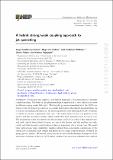| dc.contributor.author | Casalderrey-Solana, Jorge | |
| dc.contributor.author | Pablos, Daniel | |
| dc.contributor.author | Rajagopal, Krishna | |
| dc.contributor.author | Gulhan, Doga Can | |
| dc.contributor.author | Milhano, José Guilherme | |
| dc.date.accessioned | 2016-06-17T19:51:31Z | |
| dc.date.available | 2016-06-17T19:51:31Z | |
| dc.date.issued | 2014-10 | |
| dc.date.submitted | 2014-06 | |
| dc.identifier.issn | 1029-8479 | |
| dc.identifier.uri | http://hdl.handle.net/1721.1/103148 | |
| dc.description.abstract | We propose and explore a new hybrid approach to jet quenching in a strongly coupled medium. The basis of this phenomenological approach is to treat physics processes at different energy scales differently. The high-Q[superscript 2] processes associated with the QCD evolution of the jet from its production as a single hard parton through its fragmentation, up to but not including hadronization, are treated perturbatively following DGLAP evolution, to which we ascribe a spacetime structure. The interactions between the partons in the shower and the deconfined matter within which they find themselves lead to energy loss. The momentum scales associated with the medium itself (of the order of the temperature) and with typical interactions between partons in the shower and the medium are sufficiently soft that strongly coupled physics plays an important role in energy loss. We model these interactions using qualitative insights inferred from holographic calculations of the energy loss of energetic light quarks and gluons in a strongly coupled plasma, obtained via gauge/gravity duality. We embed this hybrid model into a hydrodynamic description of the spacetime evolution of the hot QCD matter produced in heavy ion collisions and confront its predictions with experimental results for a number of observables that have been measured in high energy jet data from heavy ion collisions at the LHC, including jet R[subscript AA] as a function of transverse momentum, the dijet asymmetry, and the jet fragmentation function ratio, all as functions of collision centrality. The holographic expression for the energy loss of a light quark or gluon that we incorporate in our hybrid model is parametrized by a stopping distance. We find very good agreement with all the data as long as we choose a stopping distance that is comparable to but somewhat longer than that in N=4 supersymmetric Yang-Mills theory. For comparison, we also construct analogous alternative models in which we assume that energy loss occurs as it would if the plasma were weakly coupled. We close with suggestions of observables that could provide more incisive evidence for, or against, the importance of strongly coupled physics in jet quenching. | en_US |
| dc.description.sponsorship | United States. Dept. of Energy (cooperative research agreement DE-FG0205ER41360) | en_US |
| dc.publisher | Springer Berlin Heidelberg | en_US |
| dc.relation.isversionof | http://dx.doi.org/10.1007/JHEP10(2014)019 | en_US |
| dc.rights | Creative Commons Attribution | en_US |
| dc.rights.uri | http://creativecommons.org/licenses/by/4.0/ | en_US |
| dc.source | Springer Berlin Heidelberg | en_US |
| dc.title | A hybrid strong/weak coupling approach to jet quenching | en_US |
| dc.type | Article | en_US |
| dc.identifier.citation | Casalderrey-Solana, Jorge et al. “A Hybrid Strong/weak Coupling Approach to Jet Quenching.” Journal of High Energy Physics 2014.10 (2014): n. pag. | en_US |
| dc.contributor.department | Massachusetts Institute of Technology. Center for Theoretical Physics | en_US |
| dc.contributor.department | Massachusetts Institute of Technology. Department of Physics | en_US |
| dc.contributor.department | Massachusetts Institute of Technology. Laboratory for Nuclear Science | en_US |
| dc.contributor.mitauthor | Rajagopal, Krishna | en_US |
| dc.contributor.mitauthor | Gulhan, Doga Can | en_US |
| dc.relation.journal | Journal of High Energy Physics | en_US |
| dc.eprint.version | Final published version | en_US |
| dc.type.uri | http://purl.org/eprint/type/JournalArticle | en_US |
| eprint.status | http://purl.org/eprint/status/PeerReviewed | en_US |
| dc.date.updated | 2016-05-23T09:36:45Z | |
| dc.language.rfc3066 | en | |
| dc.rights.holder | The Author(s) | |
| dspace.orderedauthors | Casalderrey-Solana, Jorge; Gulhan, Doga Can; Milhano, José Guilherme; Pablos, Daniel; Rajagopal, Krishna | en_US |
| dspace.embargo.terms | N | en_US |
| dc.identifier.orcid | https://orcid.org/0000-0001-9236-6621 | |
| dc.identifier.orcid | https://orcid.org/0000-0001-5812-8718 | |
| mit.license | PUBLISHER_CC | en_US |
